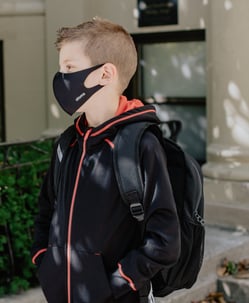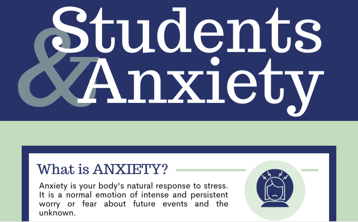We can feel the buzz in the air and vibrance in everyone’s step. I’m not talking about spring fever, I’m referring to our hope and excitement as we begin to imagine living in a post-pandemic world. As vaccinations become more widespread, so does everyone’s anticipation for a life resembling what we once had prior to COVID-19.
But will your child be ready? 
We will never forget the fear as the pandemic blanketed us and the outside world closed. Overnight, schools went online or hybrid and Zoom became a student’s platform, while life as they had known it stopped. No one is living the same life as they were before COVID.
Now, finally, it’s here… you may be feeling cautiously optimistic about the big reopening. But wrapped in this optimism may be the undercurrent of anxiety in your child, and frankly, in all of us.
What can we do to help our children prepare? Now is the time to support them for the oncoming return to face-to-face learning and socializing before they are thrown into full-time, in-person school instruction. In other words, this moment is the perfect opportunity to create a reopening plan with your child. You may be an extrovert and can’t wait to be surrounded by all of your friends again, or perhaps you are trying to hold onto this “hibernating cocoon” that you and your family have created (and that part of you may want to hold onto.) But how about your child? What might they be thinking?
In reality, this whole school reopening process is likely to be a mixed bag for students. Even if they’re optimistic, they may soon find that this return is not what they expected. It’s likely they won’t have the same opportunities to see their friends smile (thanks to masks), or to high-five each other or share snacks as they could before - and even the most outgoing students may find their social skills are a bit rusty. Simply put, they’re going back to school, but it’s not like anything they’ve ever experienced - which means some anxiety is only natural. This is where making a plan comes into play - or in other words, a detailed strategy to manage these worries and reach an end-goal. In this article, we’ll be exploring how to create a plan using our RoadMAP approach. Let’s dig in!
Questions to help your child plan for school reopening
First and foremost, we’ll start with the “road” piece. Like creating any road, you have to start at the beginning. In this case, we’ll start with your child’s vision for what they want life to look like after they’ve resettled into their school routine. To do this, first ask your child to describe in detail how they want a “regular” school day to look after the reopening, and write down what they say. Questions to consider include:
- What will your new after-school routine look like?
- How will you have to adjust your current habits with the return to in-person learning?
- What do you need to feel happy and positive about school and your friendships?
- How will you greet your friends if you need to stay distanced?
- How will you show how you’re feeling to friends and teachers if you need to wear a mask?
By formulating a clear vision for what life could look like once they’re back in school, you can work with your student to create a specific goal that they can work towards. This leads us to our next part - creating your custom reopening MAP, or in other words
Maximize their resources
Address their Anxiety
Prioritize their end goal
With this system, you can carve out a plan that’s realistic, actionable, and - most importantly - addresses your child’s concerns.
M: Maximize Their Resources
So let’s start at the “M”: What do we mean by maximizing their resources? Simply put, it’s planning ahead for how they’re going to manage the demands of in-person (or hybrid) learning after such a long time in virtual mode.
For many students, their goal is likely to be staying on top of day-to-day homework assignments now that the workload is likely to pick up again. Some resources to consider maximizing could be:
- A morning routine that allows for time to have breakfast and get out the door without stress and rushing
- A planner to write homework assignments down during each class
- An after-school schedule or calendar to write down when they’ll work on assignments.
- An online learning resource like Khan Academy that can help review concepts from school subjects
- A friend from class that they can reach out to if they need clarification with assignments
- A support system they can lean on if things feel overwhelming (i.e., a coach, guidance counselor, parent, etc.)
Although this is an academic example, the same approach still works for non-academic goals. If your student’s goals are related to their social life or extracurriculars, think about what the relevant resources could be and how they might access them to their fullest potential.
A: Address Their Anxiety
So you have your goals, resources, and an idea of how to use them effectively - what’s next? It doesn’t matter if your child is outgoing or an introvert - getting back into “regular” life may seem daunting. When picturing that return to near-normalcy, it’s important to be aware of the worries your child may have around the transition - especially the ones that could hold them back from reaching their goal. This is where the Anxiety-Action technique comes into play.
First, have your student write out the things they’re worried about. Then, brainstorm with your student to come up with an action for how they’ll handle each worry. This both addresses the anxiety in the short term by showing that there’s a way to manage it, while also creating a plan for how to deal with it in the long term - if it arises. Here’s what a list for a student who wants to get their old social life back and keep up to date with their schoolwork might look like.
|
Anxiety |
Action |
|
I’m worried my friends may have moved on to other groups |
I’ll reconnect with them now via text or social media before we go back. |
|
I’m nervous that I won’t be able to keep up with the homework assignments |
I’ll ask my teacher how they would break up the assignments, and create a schedule for myself each day to keep up |
|
It might be hard to concentrate in class every day after learning from home for so long |
I’ll start asking more questions in class so that I keep myself more focused and engaged |
|
I’m not sure I’ll be able to get out of bed early each day |
I’ll start making myself get up with an alarm a few days before school starts back up |
|
How will I get my homework done if I’m at school all day? |
I’ll create an after school timeline with scheduled breaks |
P: Prioritizing Their End Goal
Lastly, once you’ve made it this far (congratulations!), take a step back and look at your plan overall. You should have a solid starting point, target goal, resources, and actions to handle the anxiety. This is where prioritizing the end goal comes in. Make sure your student can clearly articulate why they want to achieve this end-goal and encourage them to commit to making it their main focus. This may seem like the simplest step, but really sticking with the follow-through once you’ve established a plan can be tricky. Having the right support along the way is critical, so make sure your student has someone they want to work with to stay accountable.
We have been excitedly waiting for our children to go back to school full-time and in-person, but we’re all realizing that the transition won’t necessarily be a piece of cake. Hopefully, by creating a RoadMAP and following these steps, you can help your child create a realistic reopening plan with detailed steps to achieve their individual goals. Your child is about to explore the beginnings of a post-pandemic world. With the right support, they can feel confident and prepared to tackle this next chapter while appreciating some regained freedom.
Photo by Kelly Sikkema
Download our latest infographic to learn 6 tips for helping students cope with anxiety.


